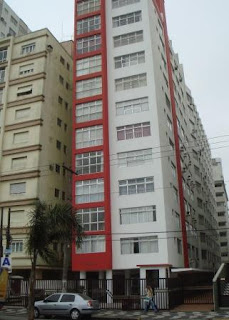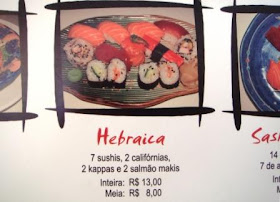 If I had taken the time to look at a map more carefully, we would not have made Sao Paulo our first stop in South America. It lies between Rio de Janeiro and Buenos Aires-two cities we want to visit. But as events unfolded, it was the perfect place to start.
If I had taken the time to look at a map more carefully, we would not have made Sao Paulo our first stop in South America. It lies between Rio de Janeiro and Buenos Aires-two cities we want to visit. But as events unfolded, it was the perfect place to start.
By the time we checked in at the airport, Sally's cold was so bad she was questioning w hether we should fly. She was so sick she even refused champagne in the lounge. (That should give her friends Evelyn and Teresa some indication of how bad she was!) But we had our boarding cards, our hotel in Sao Paulo was booked, and she just didn't want to turn back. So with a generous supply of nasal spray from the airport clinic, we set off.
hether we should fly. She was so sick she even refused champagne in the lounge. (That should give her friends Evelyn and Teresa some indication of how bad she was!) But we had our boarding cards, our hotel in Sao Paulo was booked, and she just didn't want to turn back. So with a generous supply of nasal spray from the airport clinic, we set off.
We really didn't know what to expect in Sao Paulo, except for one thing. Five years ago in Vancouver, I met an engineer/builder from Sao Paulo who was considering relocating to our city. Although he and his family enjoyed a good and successful life in Sao Paulo, they were concerned with the increasing level of crime and the state of the government in Brazil. I showed him around and introduced him to a few people. They came to dinner, and we had such a delightful evening, we agreed to keep in touch. And we have, sending each other holiday greetings over the intervening years.
Consequently, when we arrived, we had a friend to help orient us to the city, and more importantly, arrange for Sally to see a doctor! Over the next few days, Andre and his family took us around, entertained us, and gave us an insight into what life is like for a middle class family in this very large and oftentimes dangerous city.

 Sao Paulo’s population is between 12and 16 million depending on where you draw its boundaries. It is the largest in South America and the fifth largest in the world. It began in the 16th
Sao Paulo’s population is between 12and 16 million depending on where you draw its boundaries. It is the largest in South America and the fifth largest in the world. It began in the 16th C but few old buildings or neighbourhoods remain. While Sally waited for her medication to kick in, I set off for a walk along Paulista Avenue, a grand commercial street where Andre had advised us to stay, and the central historic area.
C but few old buildings or neighbourhoods remain. While Sally waited for her medication to kick in, I set off for a walk along Paulista Avenue, a grand commercial street where Andre had advised us to stay, and the central historic area.
Sao Paulo is a city of contrasts. In addition to some grand old buildings, and landmark designs by Oscar Niemeyer, one of Brazil’s favourite architects, there are a variety of buildings, including modern office towers, and rather ordinary apartment blocks. While there was a lot of ‘good graffiti’ (as my daughter Claire would say), I was horrified to see that not only were the ‘artists’ marking up street level walls and surfaces, but they were tagging upper floors as well. I saw 15 story apartment blocks with graffiti up to the 10th floor balconies! No wonder Andre was thinking about leaving.
But there are some impressive squares and public art. The streets are alive with people. There are shoe shine stands, street performers, fortune tellers, street vendors, and religious leaders with microphones. 
You can buy all sorts of food, and enough sunglasses to equip the entire city population. There are also plenty of police around, although many of the police look far more dangerous than the potential criminals.
Over the next few days, while constantly vigilant about pickpockets and potential muggers, I traveled around by foot and the very clean and efficient metro. I was advised to avoid buses, and I did. When we wanted to go out for a Brazilian barbq dinner, the restaurant sent a van to pick us up at the hotel.  Although many parts of the city were overrun by crime and poverty, in many, many others, life seemed as normal as in Vancouver. We went into a large bookstore recommended by Andre, and could have been in the Robson Street Chapters. Except for one thing. This one had an even larger English language travel book selection!
Although many parts of the city were overrun by crime and poverty, in many, many others, life seemed as normal as in Vancouver. We went into a large bookstore recommended by Andre, and could have been in the Robson Street Chapters. Except for one thing. This one had an even larger English language travel book selection!
In the hope that I might better understand the country, Andre gave me a copy of an April 2007 Economist Special Report on Brazil. It was both critical and optimistic. In 2003, Goldman Sachs picked Brazil, along with Russia, India and China as one of the four countries that would share dominance of the world economy by 2050. However, ‘Brazil is the country of the future and always will be' goes a popular joke. According to the article, it is an economic powerhouse, but can’t afford to feed and educate its children, and corruption is at the core of the problem.
Brazil returned to democracy in 1988 after 20 years of military rule. Although it suffered very high levels of inflation, in the last couple of years the rate has dropped to about 3%. In fact the Real, the local currency has gained considerably against the US dollar in recent years, and is relatively strong. A cup of coffee at the bookstore café cost the same as at Starbucks. A taxi from the airport was around $45. (By the way, the airport that experienced the recent crash was a smaller domestic airport, not the main international airport. As usual, this wasn’t clarified by any of the news accounts we read.) Furthermore, almost all the taxis, and 80% of the new cars run on biofuel-alcohol made from sugarcane-which costs about half the price of regular gasoline.
Andre and his family showed us a great time. We saw many beautiful neighbourhoods, and parks. But in the distance were the favelas or slums, climbing up the hillsides and looking deceptively like quaint Italian hillside towns. Most of the dwellings were built by squatters, initially with cardboard boxes and plastic sheeting. Over time, corrugated metal sheeting and bricks were added. The neighbourhoods are controlled by drug lords. However, according to the Economist, governments are attempting to improve the lives of these residents and some progress is being made in closing the gap between the rich and poor. But there is a long way to go.
We avoided that side of life. Instead we had a wonderful Friday night dinner at Andre and Eliane’s home in a very nice part of the city. The next day we spent an afternoon at a nearby seaside resort, in an apartment owned by Eliane's parents. Unfortunately, the weather changed and it was quite cool and starting to rain. But the building staff still set up chairs and an umbrella for us on the beach.
As we drove around nearby Santos, we saw condominiums with a very unfortunate problem. They weren’t leaking; they were leaning! Literally dozens of buildings have started to settle unevenly.
On Sunday afternoon, we were given a tour of their club. To get in, we were not only signed in, we had to show proper identification and have our photos taken. Once inside, we understood why. The Hebraic Club is like an entire village, covering twenty acres. It has 5 swimming pools, various gymnasiums, tennis courts, a concert hall, library, synagogue, and a variety of cafes and restaurants spread out amongst the tropical grounds.

We had lunch at Tana be, the Japanese restaurant, and remarked on the absurdity of having an excellent Japanese meal in a Jewish club in South America.
be, the Japanese restaurant, and remarked on the absurdity of having an excellent Japanese meal in a Jewish club in South America.
After four very interesting days, it was time to move on. We were advised to go to Rio by bus, rather than take a chance on the local airport. It’s not that it’s unsafe, we were told. You just never know if the flights will take off! Thanks to Andre, Eliane, Gabriel and Ariel, we got a very good impression of the city. But while we would love to have them in Vancouver, there’s no chance that we’ll be moving to Sao Paulo.
 If I had taken the time to look at a map more carefully, we would not have made Sao Paulo our first stop in
If I had taken the time to look at a map more carefully, we would not have made Sao Paulo our first stop in 















You, guys had an interesting trip! Pictures are nice! I like it!
ReplyDeleteI have been to Brazil and like it very much! I want to vizit and probably buy in Brazil property, and live there every summer! My dream is to live close to ocean! Thank you and good luck!